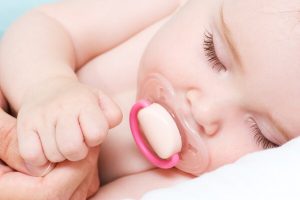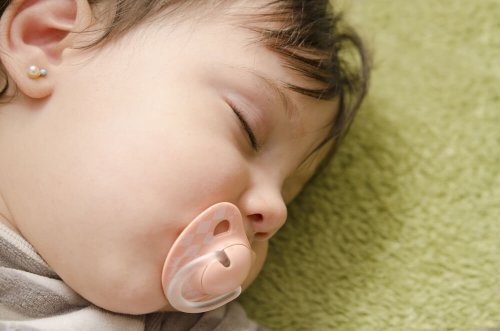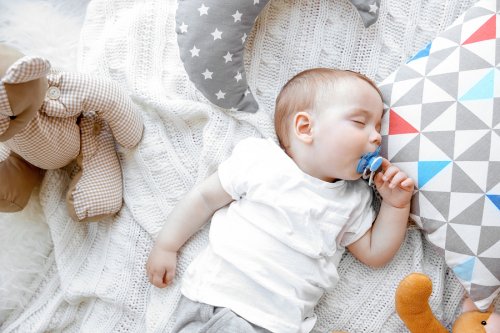Is It Okay for Babies to Sleep with a Pacifier?

When it comes time to go to bed, pacifiers can be very useful for babies who find it comforting to have something to suck on. Although many parents wonder whether it’s ok or not to let their children sleep with a pacifier, the answer is yes, it is.
There is no risk in allowing our children to sleep with a pacifier!
Babies have a desire to suck when they’re tired, bored or merely need comfort. Some may require the pacifier more than others and, in this sense, having one to suck on can provide the peace of mind necessary to get a good night’s rest.
Of course, if the pacifier falls out while the child sleeps, it’s not necessary to put it back into his mouth.
However, if you’re still breastfeeding the baby, we recommend that you wait before switching to a pacifier. This way, you’ll make sure that lactation is well established.
Establishing lactation usually takes three to four weeks. Pacifiers can be used to calm your baby down once you know he’s well nourished and no longer hungry.
Moreover, research has shown that sleeping with a pacifier isn’t a critical factor for getting a good night’s rest.
In fact, there are no significant differences in sleep patterns between babies who sleep with a pacifier and those who don’t. Therefore, parents shouldn’t worry too much if their children can’t get to sleep without a pacifier.
Is it okay for children to sleep with a pacifier?
The answer is yes, it’s safe for you to give your baby a pacifier before bedtime. However, it’s necessary that you take into account some guidelines to make sure you’re doing it in the safest way possible.

Take note. We’ll tell you everything you need to know about the use of pacifiers here:
- Don’t tie a string to the pacifier, it increases the risk of strangulation.
- Don’t give your baby a pacifier at night while he’s learning to breastfeed.
- Make sure to keep the pacifier clean and disinfect it with hot water always.
- Use the correct pacifier size, which matches the baby’s age.
- Don’t cover the pacifier with anything.
- You should only use one-piece pacifiers.
- The pacifier should have breathing holes in the protector.
“Sleeping with a pacifier isn’t a critical factor for getting a good night’s rest since there are no significant differences in sleep patterns between babies who sleep with a pacifier and those who don’t. “
Benefits of sleeping with a pacifier
The first and the most apparent benefit of sleeping with a pacifier is the overall calming sensation it provides. When babies love their pacifiers, they won’t abandon them quickly, even if it’s nap time or if it’s time to go to bed. And, as you can imagine, a quiet baby is synonymous to calm parents.
If you notice that your baby becomes stressed and gets in a bad mood when you try taking away the pacifier before bedtime, think twice: remember that it makes them feel better and has no negative consequences. Having a pacifier to suck on generates calmness, which in turn makes it easier to fall asleep.
Another important advantage of sleeping with a pacifier is that it reduces the risk of Sudden Infant Death Syndrome. In fact, it reduces the chances by half.
Furthermore, a pacifier can help babies learn to control their feelings, help them to relax and make them feel safe when it’s bedtime.

Accordingly, multiple studies have found that using a pacifier correlates with a lowered risk of Sudden Infant Death Syndrome. The reasons for the positive effects aren’t clear yet, but the research is quite firm: by giving babies a pacifier at night, you can help reduce the chances of them suffering from this problem.
In conclusion, remember that it’s not bad for children to sleep with a pacifier. If you notice that your baby doesn’t want to get rid of the pacifier while he or she sleeps, you shouldn’t worry. Sucking on a pacifier has some very important benefits for our children’s well-being.
When it comes time to go to bed, pacifiers can be very useful for babies who find it comforting to have something to suck on. Although many parents wonder whether it’s ok or not to let their children sleep with a pacifier, the answer is yes, it is.
There is no risk in allowing our children to sleep with a pacifier!
Babies have a desire to suck when they’re tired, bored or merely need comfort. Some may require the pacifier more than others and, in this sense, having one to suck on can provide the peace of mind necessary to get a good night’s rest.
Of course, if the pacifier falls out while the child sleeps, it’s not necessary to put it back into his mouth.
However, if you’re still breastfeeding the baby, we recommend that you wait before switching to a pacifier. This way, you’ll make sure that lactation is well established.
Establishing lactation usually takes three to four weeks. Pacifiers can be used to calm your baby down once you know he’s well nourished and no longer hungry.
Moreover, research has shown that sleeping with a pacifier isn’t a critical factor for getting a good night’s rest.
In fact, there are no significant differences in sleep patterns between babies who sleep with a pacifier and those who don’t. Therefore, parents shouldn’t worry too much if their children can’t get to sleep without a pacifier.
Is it okay for children to sleep with a pacifier?
The answer is yes, it’s safe for you to give your baby a pacifier before bedtime. However, it’s necessary that you take into account some guidelines to make sure you’re doing it in the safest way possible.

Take note. We’ll tell you everything you need to know about the use of pacifiers here:
- Don’t tie a string to the pacifier, it increases the risk of strangulation.
- Don’t give your baby a pacifier at night while he’s learning to breastfeed.
- Make sure to keep the pacifier clean and disinfect it with hot water always.
- Use the correct pacifier size, which matches the baby’s age.
- Don’t cover the pacifier with anything.
- You should only use one-piece pacifiers.
- The pacifier should have breathing holes in the protector.
“Sleeping with a pacifier isn’t a critical factor for getting a good night’s rest since there are no significant differences in sleep patterns between babies who sleep with a pacifier and those who don’t. “
Benefits of sleeping with a pacifier
The first and the most apparent benefit of sleeping with a pacifier is the overall calming sensation it provides. When babies love their pacifiers, they won’t abandon them quickly, even if it’s nap time or if it’s time to go to bed. And, as you can imagine, a quiet baby is synonymous to calm parents.
If you notice that your baby becomes stressed and gets in a bad mood when you try taking away the pacifier before bedtime, think twice: remember that it makes them feel better and has no negative consequences. Having a pacifier to suck on generates calmness, which in turn makes it easier to fall asleep.
Another important advantage of sleeping with a pacifier is that it reduces the risk of Sudden Infant Death Syndrome. In fact, it reduces the chances by half.
Furthermore, a pacifier can help babies learn to control their feelings, help them to relax and make them feel safe when it’s bedtime.

Accordingly, multiple studies have found that using a pacifier correlates with a lowered risk of Sudden Infant Death Syndrome. The reasons for the positive effects aren’t clear yet, but the research is quite firm: by giving babies a pacifier at night, you can help reduce the chances of them suffering from this problem.
In conclusion, remember that it’s not bad for children to sleep with a pacifier. If you notice that your baby doesn’t want to get rid of the pacifier while he or she sleeps, you shouldn’t worry. Sucking on a pacifier has some very important benefits for our children’s well-being.
All cited sources were thoroughly reviewed by our team to ensure their quality, reliability, currency, and validity. The bibliography of this article was considered reliable and of academic or scientific accuracy.
- American Academy of Pediatrics. (2019, November 29). Pacifiers and Thumb Sucking. Consultado el 9 de febrero de 2023. Disponible en: https://www.healthychildren.org/English/ages-stages/baby/crying-colic/Pages/Pacifiers-and-Thumb-Sucking.aspx
- American Academy of Pediatrics. (2005). Breastfeeding and the Use of Human Milk. Pediatrics, 115(2), 496–506. Disponible en: https://publications.aap.org/pediatrics/article-abstract/115/2/496/67351/Breastfeeding-and-the-Use-of-Human-Milk?redirectedFrom=fulltext?autologincheck=redirected
- Asociación Española de Pediatría (2011). Uso del chupete y lactancia materna. Consultado el 9 de febrero de 2023. Disponible en: https://www.aeped.es/comite-nutricion-y-lactancia-materna/lactancia-materna/documentos/uso-chupete-y-lactancia-materna
- Asociación Española de Pediatría. (2018, 14 de septiembre). Chupete. Consultado el 9 de febrero de 2023. Disponible en: https://enfamilia.aeped.es/edades-etapas/chupete
- Bencosme, J. (2016). Chupetes para bebés: ¿Qué necesitan saber las enfermeras? Nursing. Disponible en: https://www.sciencedirect.com/science/article/abs/pii/S0212538216301297?via%3Dihub
- Butler, R., Moore, M. & Mindell, J. (2016). Pacifier use, finger sucking, and infant sleep. Behavioral sleep medicine, 14(6), 615-623. Disponible en: https://www.tandfonline.com/doi/abs/10.1080/15402002.2015.1048451?src=recsys&journalCode=hbsm20
- Canadian Paediatric Society (2003). Recommendations for the use of pacifiers. Paediatrics & Child Health, 8(8), 515-519. Disponible en: https://www.ncbi.nlm.nih.gov/pmc/articles/PMC2791559/
- De La Torre, M. L., Alonso, C. P., Aguilar, M. H., et al. (2011). Uso del chupete y lactancia materna. Anales De Pediatria. Disponible en: https://www.sciencedirect.com/science/article/abs/pii/S1695403310004777?via%3Dihub
- Diaz, V. y Moreno, N. (2018). Eficacia del uso del chupete en la disminución de la muerte súbita en lactantes [Tesis de especialización, Universidad Privada Norbert Wiener]. Repositorio Universidad Privada Norbert Wiener. Disponible en: https://repositorio.uwiener.edu.pe/handle/20.500.13053/2027
- Jenik, A., Grad, E. y Orazi, V. (2015). Consideraciones sobre el sueño seguro del lactante. Resumen ejecutivo. Arch Argent Pediatr, 113(3), 1-19. Disponible en: http://www.scielo.org.ar/scielo.php?script=sci_arttext&pid=S0325-00752015000300023
- Kanopa, V., Pérez, W., Rubio, I., et al. (2022). Sueño seguro, lactancia y colecho. Recomendaciones del Comité de Lactancia y el Comité de Estudio y Prevención de la Muerte Súbita e Inesperada del Lactante. Sociedad Uruguaya de Pediatría. Archivos de Pediatría del Uruguay, 93(1), 1-3. Disponible en: http://www.scielo.edu.uy/scielo.php?pid=S1688-12492022000101802&script=sci_arttext
- Lubbe, W. & Ham-Baloyi, W. T. (2017). When is the use of pacifiers justifiable in the baby-friendly hospital initiative context? A clinician’s guide. BMC Pregnancy and Childbirth, 17(1). Disponible en: https://bmcpregnancychildbirth.biomedcentral.com/articles/10.1186/s12884-017-1306-8
- National Institute of Child Health and Human Development (2015, March 2). Preguntas frecuentes sobre el síndrome de muerte súbita del bebé y el sueño seguro para los bebés. Consultado el 9 de febrero de 2023. Disponible en: https://espanol.nichd.nih.gov/actividades-proyectos/sts/preguntas
- Sánchez, L., González, E., Florensa, S. & Marti, J. (2000). Uso del chupete: beneficios y riesgos. In Anales de Pediatría, 53(6), 580-585). Disponible en: https://www.analesdepediatria.org/es-pdf-S1695403300775023
- Sexton, S. M. & Natale, R. (2009). Risks and benefits of pacifiers. American family physician, 79(8), 681-685. Disponible en: https://www.aafp.org/pubs/afp/issues/2009/0415/p681.html#benefits
- Varas, V. y Gil, B. (2012). Hábito de succión del chupete y alteraciones dentarias asociadas. Importancia del diagnóstico precoz. Anales de Pediatría 77(6), 374-380). Disponible en: https://www.sciencedirect.com/science/article/abs/pii/S1695403312001518
This text is provided for informational purposes only and does not replace consultation with a professional. If in doubt, consult your specialist.








